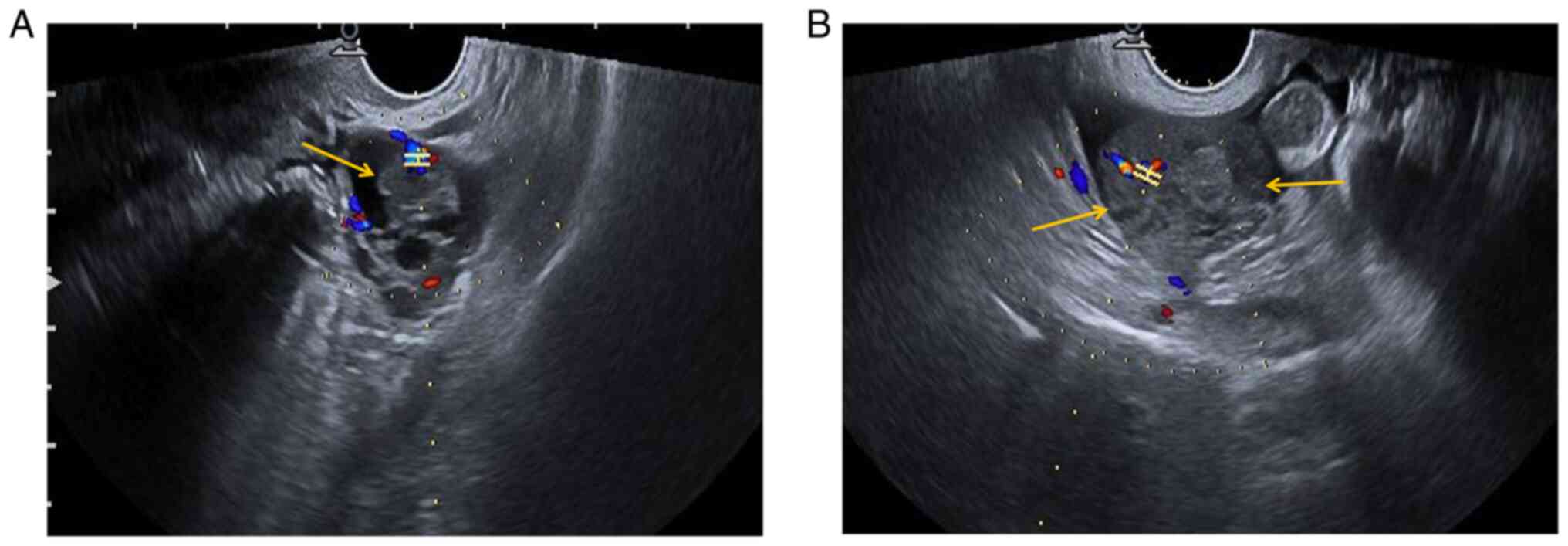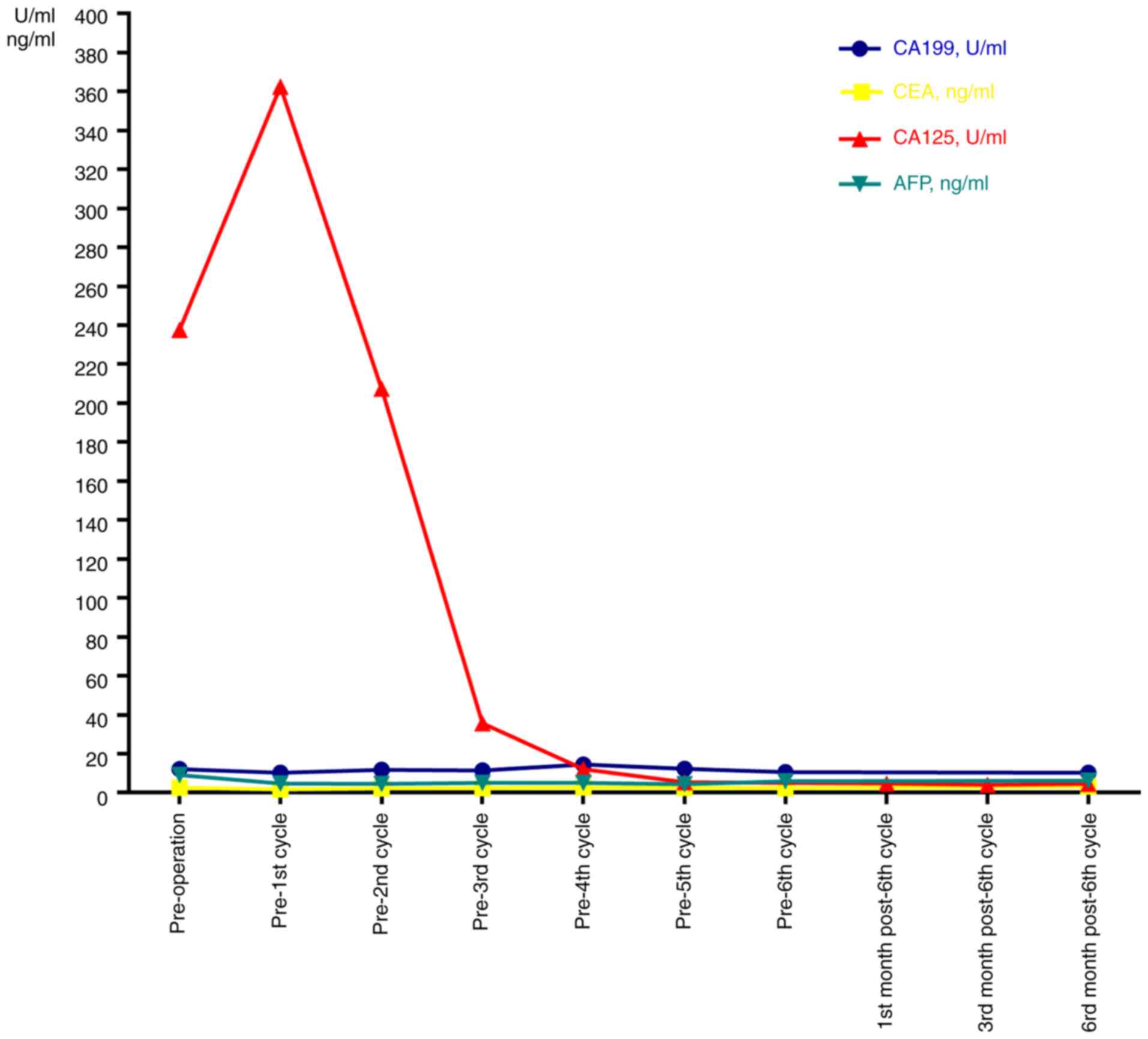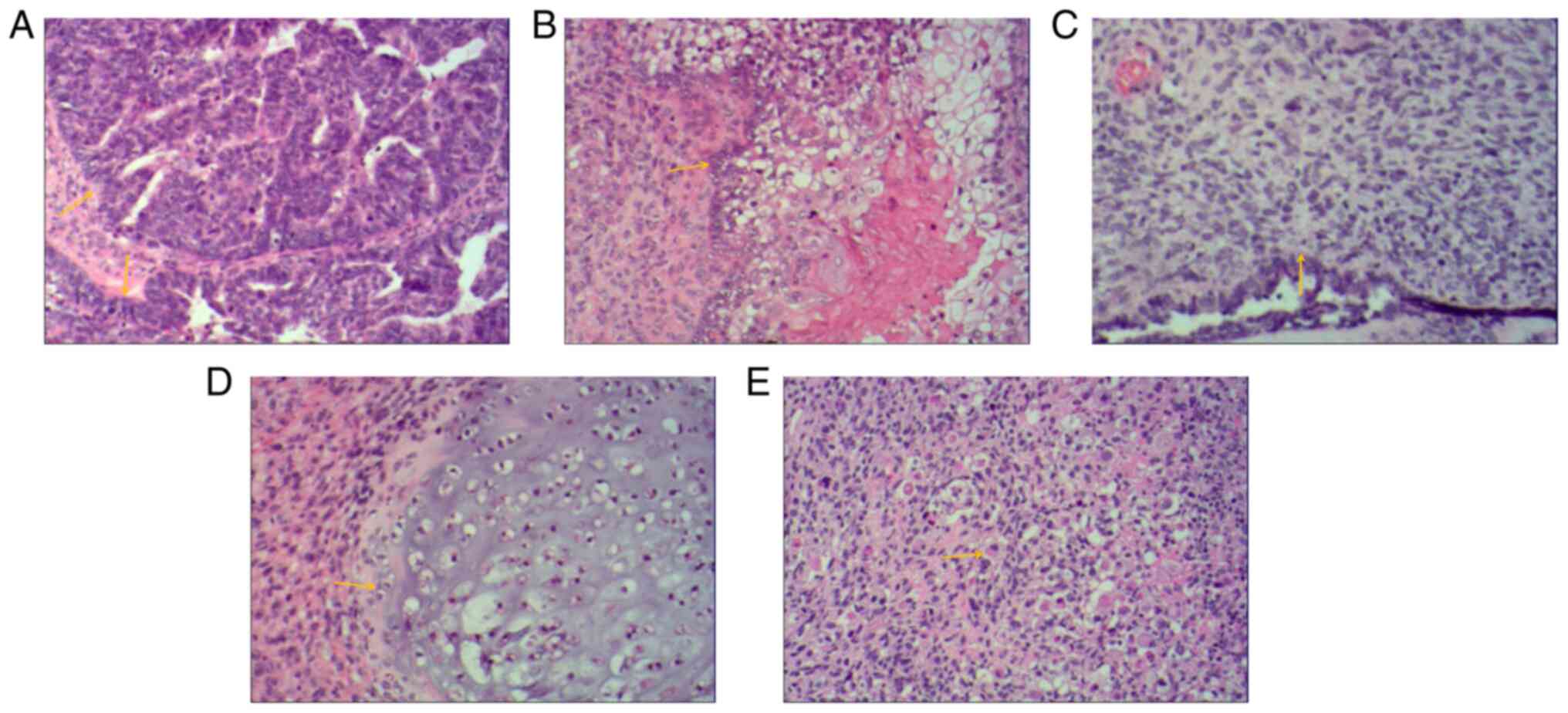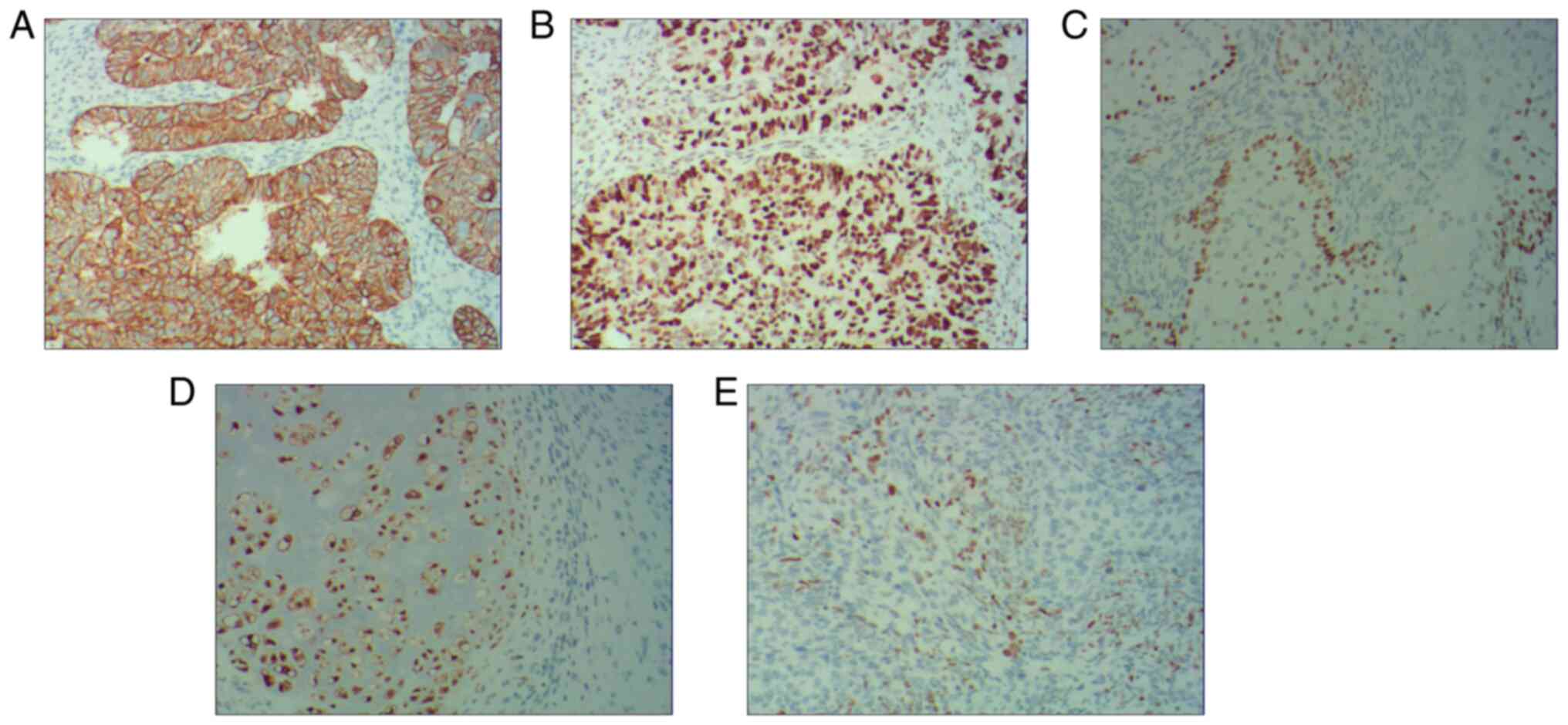|
1
|
del Carmen MG, Birrer M and Schorge JO:
Carcinosarcoma of the ovary: A review of the literature. Gynecol
Oncol. 125:271–277. 2012.PubMed/NCBI View Article : Google Scholar
|
|
2
|
Le T, Krepart GV, Lotocki RJ and Heywood
MS: Malignant mixed mesodermal ovarian tumor treatment and
prognosis: A 20-year experience. Gynecol Oncol. 65:237–240.
1997.PubMed/NCBI View Article : Google Scholar
|
|
3
|
Trento M, Munari G, Carraro V, Lanza C,
Salmaso R, Pizzi S, Santoro L, Chiarelli S, Dal Santo L, Nardelli
GB, et al: Mutational and immunophenotypic profiling of a series of
8 Tubo-ovarian carcinosarcomas revealed a monoclonal origin of the
disease. Int J Gynecol Pathol. 39:305–312. 2020.PubMed/NCBI View Article : Google Scholar
|
|
4
|
Barnholtz-Sloan JS, Morris R, Malone JM Jr
and Munkarah AR: Survival of women diagnosed with malignant, mixed
mullerian tumors of the ovary (OMMMT). Gynecol Oncol. 93:506–512.
2004.PubMed/NCBI View Article : Google Scholar
|
|
5
|
Duska LR, Garrett A, Eltabbakh GH, Oliva
E, Penson R and Fuller AF: Paclitaxel and platinum chemotherapy for
malignant mixed müllerian tumors of the ovary. Gynecol Oncol.
85:459–463. 2002.PubMed/NCBI View Article : Google Scholar
|
|
6
|
Huang Y, Li XM, Chen SG, Deng J, Lei Y, Li
WJ, Zhang HZ, Zhang H, Li D and Xie P: Application of antibodies
against Borna disease virus phosphoprotein and nucleoprotein on
paraffin sections. Mol Med Rep. 17:5416–5422. 2018.PubMed/NCBI View Article : Google Scholar
|
|
7
|
Pinheiro C, Roque R, Adriano A, Mendes P,
Praça M, Reis I, Pereira T, Srebotnik Kirbis I and André S:
Optimization of immunocytochemistry in cytology: comparison of two
protocols for fixation and preservation on cytospin and smear
preparations. Cytopathology. 26:38–43. 2015.PubMed/NCBI View Article : Google Scholar
|
|
8
|
Stover EH, Fuh K, Konstantinopoulos PA,
Matulonis UA and Liu JF: Clinical assays for assessment of
homologous recombination DNA repair deficiency. Gynecol Oncol.
159:887–898. 2020.PubMed/NCBI View Article : Google Scholar
|
|
9
|
van Warmerdam LJ, Rodenhuis S, ten Bokkel
Huinink WW, Maes RA and Beijnen JH: The use of the Calvert formula
to determine the optimal carboplatin dosage. J Cancer Res Clin
Oncol. 121:478–486. 1995.PubMed/NCBI View Article : Google Scholar
|
|
10
|
Pankaj S, Nazneen S, Kumari A, Kumari S,
Choudhary V and Roy VK: A rare tumor of the ovary: carcinosarcoma
report and review of literature. J Obstet Gynaecol India.
66:648–650. 2016.PubMed/NCBI View Article : Google Scholar
|
|
11
|
McCluggage WG, Lioe TF, McClelland HR and
Lamki H: Rhabdomyosarcoma of the uterus: report of two cases,
including one of the spindle cell variant. Int J Gynecol Cancer.
12:128–132. 2002.PubMed/NCBI View Article : Google Scholar
|
|
12
|
Ciccarone F, Biscione A, Moro F,
Fischerova D, Savelli L, Munaretto M, Jokubkiene L, Sladkevicius P,
Chiappa V, Fruscio R, et al: Imaging in gynecological disease:
clinical and ultrasound characteristics of ovarian carcinosarcomas.
Ultrasound Obstet Gynecol. 59:241–247. 2022.PubMed/NCBI View Article : Google Scholar
|
|
13
|
Saida T, Mori K, Tanaka YO, Sakai M, Amano
T, Kikuchi S, Masuoka S, Yoshida M, Masumoto T, Satoh T, et al:
Carcinosarcoma of the ovary: MR and clinical findings compared with
high-grade serous carcinoma. Jpn J Radiol. 39:357–366.
2021.PubMed/NCBI View Article : Google Scholar
|
|
14
|
Dasgupta S, Bose D, Bhattacharyya NK and
Biswas PK: Carcinosarcoma of ovary with its various
immunohistochemical expression: Report of a rare case. J Cancer Res
Ther. 11(1022)2015.PubMed/NCBI View Article : Google Scholar
|
|
15
|
Carnevali IW, Cimetti L, Sahnane N, Libera
L, Cavallero A, Formenti G, Riva C and Tibiletti MG: Two cases of
carcinosarcomas of the ovary involved in hereditary cancer
syndromes. Int J Gynecol Pathol. 36:64–70. 2017.PubMed/NCBI View Article : Google Scholar
|
|
16
|
Sood AK, Sorosky JI, Gelder MS, Buller RE,
Anderson B, Wilkinson EJ, Benda JA and Morgan LS: Primary ovarian
sarcoma: Analysis of prognostic variables and the role of surgical
cytoreduction. Cancer. 82:1731–1737. 1998.PubMed/NCBI
|
|
17
|
Raji R, Guzzo F, Carrara L, Varughese J,
Cocco E, Bellone S, Betti M, Todeschini P, Gasparrini S, Ratner E,
et al: Uterine and ovarian carcinosarcomas overexpressing Trop-2
are sensitive to hRS7, a humanized anti-Trop-2 antibody. J Exp Clin
Cancer Res. 30(106)2011.PubMed/NCBI View Article : Google Scholar
|
|
18
|
Zhu J, Wen H, Ju X, Bi R, Zuo W and Wu X:
Clinical significance of programmed death Ligand-1 and
intra-tumoral CD8+ T lymphocytes in ovarian carcinosarcoma. PLoS
One. 12(e0170879)2017.PubMed/NCBI View Article : Google Scholar
|
|
19
|
Rauh-Hain JA, Gonzalez R, Bregar AJ,
Clemmer J, Hernández-Blanquisett A, Clark RM, Schorge JO and Del
Carmen MG: Patterns of care, predictors and outcomes of
chemotherapy for ovarian carcinosarcoma: A national cancer database
analysis. Gynecol Oncol. 142:38–43. 2016.PubMed/NCBI View Article : Google Scholar
|
|
20
|
Paulsson G, Andersson S and Sorbe B: A
population-based series of ovarian carcinosarcomas with long-term
follow-up. Anticancer Res. 33:1003–1008. 2013.PubMed/NCBI
|
|
21
|
Ariyoshi K, Kawauchi S, Kaku T, Nakano H
and Tsuneyoshi M: Prognostic factors in ovarian carcinosarcoma: A
clinicopathological and immunohistochemical analysis of 23 cases.
Histopathology. 37:427–436. 2000.PubMed/NCBI View Article : Google Scholar
|
|
22
|
Zorzou MP, Markaki S, Rodolakis A,
Kastritis E, Bozas G, Dimopoulos MA and Papadimitriou CA:
Clinicopathological features of ovarian carcinosarcomas: A single
institution experience. Gynecol Oncol. 96:136–142. 2005.PubMed/NCBI View Article : Google Scholar
|
|
23
|
Doo DW, Erickson BK, Arend RC, Conner MG,
Huh WK and Leath CA III: Radical surgical cytoreduction in the
treatment of ovarian carcinosarcoma. Gynecol Oncol. 133:234–237.
2014.PubMed/NCBI View Article : Google Scholar
|
|
24
|
Brown E, Stewart M, Rye T, Al-Nafussi A,
Williams AR, Bradburn M, Smyth J and Gabra H: Carcinosarcoma of the
ovary: 19 years of prospective data from a single center. Cancer.
100:2148–2153. 2004.PubMed/NCBI View Article : Google Scholar
|
|
25
|
Wang WP, Li N, Zhang YY, Gao YT, Sun YC,
Ge L and Wu LY: Prognostic significance of lymph node metastasis
and lymphadenectomy in early-stage ovarian carcinosarcoma. Cancer
Manag Res. 10:1959–1968. 2018.PubMed/NCBI View Article : Google Scholar
|
|
26
|
Armstrong DK, Alvarez RD, Bakkum-Gamez JN,
Barroilhet L, Behbakht K, Berchuck A, Chen LM, Cristea M, DeRosa M,
Eisenhauer EL, et al: Ovarian Cancer, Version 2.2020, NCCN Clinical
Practice Guidelines in Oncology. J Natl Compr Canc Netw.
19:191–226. 2021.PubMed/NCBI View Article : Google Scholar
|
|
27
|
Rutledge TL, Gold MA, McMeekin DS, Huh WK,
Powell MA, Lewin SN, Mutch DG, Johnson GA, Walker JL and Mannel RS:
Carcinosarcoma of the ovary-a case series. Gynecol Oncol.
100:128–132. 2006.PubMed/NCBI View Article : Google Scholar
|
|
28
|
Silasi DA, Illuzzi JL, Kelly MG,
Rutherford TJ, Mor G, Azodi M and Schwartz PE: Carcinosarcoma of
the ovary. Int J Gynecol Cancer. 18:22–29. 2008.PubMed/NCBI View Article : Google Scholar
|
|
29
|
Brackmann M, Stasenko M, Uppal S, Erba J,
Reynolds RK and McLean K: Comparison of first-line chemotherapy
regimens for ovarian carcinosarcoma: A single institution case
series and review of the literature. BMC Cancer.
18(172)2018.PubMed/NCBI View Article : Google Scholar
|
|
30
|
Tate Thigpen J, Blessing JA, DeGeest K,
Look KY and Homesley HD: Cisplatin as initial chemotherapy in
ovarian carcinosarcomas: A gynecologic oncology group study.
Gynecol Oncol. 93:336–339. 2004.PubMed/NCBI View Article : Google Scholar
|
|
31
|
Muntz HG, Jones MA, Goff BA, Fuller AF Jr,
Nikrui N, Rice LW and Tarraza HM: Malignant mixed müllerian tumors
of the ovary: experience with surgical cytoreduction and
combination chemotherapy. Cancer. 76:1209–1213. 1995.PubMed/NCBI View Article : Google Scholar
|
|
32
|
George EM, Herzog TJ, Neugut AI, Lu YS,
Burke WM, Lewin SN, Hershman DL and Wright JD: Carcinosarcoma of
the ovary: natural history, patterns of treatment, and outcome.
Gynecol Oncol. 131:42–45. 2013.PubMed/NCBI View Article : Google Scholar
|
|
33
|
Berton-Rigaud D, Devouassoux-Shisheboran
M, Ledermann JA, Leitao MM, Powell MA, Poveda A, Beale P, Glasspool
RM, Creutzberg CL, Harter P, et al: Gynecologic cancer InterGroup
(GCIG) consensus review for uterine and ovarian carcinosarcoma. Int
J Gynecol Cancer. 24 (9 Suppl 3):S55–S60. 2014.PubMed/NCBI View Article : Google Scholar
|
|
34
|
Blanco Suarez JM, Amendola BE, Perez N,
Amendola M and Wu X: The use of lattice radiation therapy (LRT) in
the treatment of bulky tumors: A case report of a large metastatic
mixed mullerian ovarian tumor. Cureus. 7(e389)2015.PubMed/NCBI View Article : Google Scholar
|
|
35
|
Guzzo F, Bellone S, Buza N, Hui P, Carrara
L, Varughese J, Cocco E, Betti M, Todeschini P, Gasparrini S, et
al: HER2/neu as a potential target for immunotherapy in gynecologic
carcinosarcomas. Int J Gynecol Pathol. 31:211–221. 2012.PubMed/NCBI View Article : Google Scholar
|
|
36
|
Menderes G, Bonazzoli E, Bellone S, Black
J, Predolini F, Pettinella F, Masserdotti A, Zammataro L, Altwerger
G, Buza N, et al: SYD985, a novel duocarmycin-based HER2-targeting
antibody-drug conjugate, shows antitumor activity in uterine and
ovarian carcinosarcoma with HER2/Neu expression. Clin Cancer Res.
23:5836–5845. 2017.PubMed/NCBI View Article : Google Scholar
|
|
37
|
Ferrari F, Bellone S, Black J, Schwab CL,
Lopez S, Cocco E, Bonazzoli E, Predolini F, Menderes G, Litkouhi B,
et al: Solitomab, an EpCAM/CD3 bispecific antibody construct
(BiTE®), is highly active against primary uterine and ovarian
carcinosarcoma cell lines in vitro. J Exp Clin Cancer Res.
34(123)2015.PubMed/NCBI View Article : Google Scholar
|
|
38
|
Cubas R, Zhang S, Li M, Chen C and Yao Q:
Trop2 expression contributes to tumor pathogenesis by activating
the ERK MAPK pathway. Mol Cancer. 9(253)2010.PubMed/NCBI View Article : Google Scholar
|



















